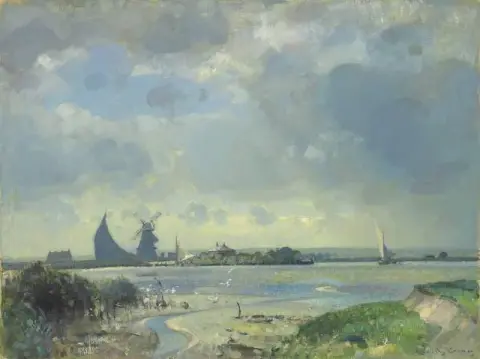Hand-painted painting reproductions - Movements - Tonalism
Imagine owning a museum-worthy piece of art, created by the greatest artists in history and reproduced by passionate and experienced painters. At POD, we offer you the opportunity to make that dream a reality. We reproduce the works of art of your favorite painters from the Tonalism art movement in the smallest details, so that you can enjoy them in your own home.
Our reproductions are made by experienced artists who use the best materials and techniques. We are committed to providing you with works of art of the highest quality, which will bring joy and inspiration to your family for generations to come.
Tonalism: A Movement Emphasizing Mood and Atmosphere
Tonalism was an American art movement that emerged in the late 19th century, characterized by a focus on subtle tonal variations and the atmospheric quality of light and color. This style was rooted in the desire to evoke mood, emotion, and a sense of mystery rather than precise details or realism. Tonalism is often associated with the works of painters like James McNeill Whistler, George Inness, and John Henry Twachtman, who sought to convey the essence of nature through a soft, diffused palette and an emphasis on the intangible qualities of light and atmosphere.
Early Development and Influences
The Tonalism movement emerged in the 1880s and flourished into the early 20th century, driven by a reaction against the more detailed and realistic styles of the time, such as those associated with the Hudson River School and academic realism. Influenced by the Romantic movement, Tonalism sought to present nature and the human condition in a more abstract, emotional, and atmospheric way. The movement was also deeply inspired by the ideas of Transcendentalism, which emphasized intuition and the connection between the individual and nature.
Tonalism was closely related to both the Barbizon School of France and the Symbolist movement, drawing on their techniques of creating soft, muted landscapes and emotional portrayals of nature. Artists in the movement were interested in creating a sense of intimacy and personal connection to the environment, often depicting quiet, serene landscapes at twilight or dawn, when light was soft and the world appeared tranquil.
Characteristics and Style
Tonalism is defined by its distinctive use of color and light. Instead of relying on bright colors and sharp contrasts, Tonalist artists used a restrained, monochromatic palette that often focused on shades of gray, brown, or muted greens and blues. This created a harmonious and unified atmosphere in their works, drawing attention to the overall mood of the scene rather than to specific objects or details.
The emphasis on light and atmosphere was a key aspect of Tonalism. Artists used soft, diffused lighting to create an ethereal quality in their paintings, often depicting scenes at dawn, dusk, or twilight. This allowed them to evoke a sense of mystery and quiet contemplation. The mood of the work was often enhanced by the use of mist, fog, or haze, contributing to the sense of dreaminess and serenity that defined Tonalist paintings.
Rather than presenting the world in a realistic manner, Tonalism sought to express the emotional and spiritual aspects of nature. Landscapes were often simplified and abstracted, with the goal of conveying a mood or feeling rather than a detailed depiction of the physical world. The work of Tonalist artists often reflected a deep sense of solitude, tranquility, and introspection.
Key Themes and Significance
The central themes of Tonalism were deeply connected to nature, light, and emotion. The artists of this movement often sought to convey the quiet, meditative aspects of nature, with landscapes that seemed to evoke a sense of timelessness and peacefulness. Unlike the more dramatic depictions of nature in earlier movements like the Hudson River School, Tonalist works focused on creating an atmosphere of stillness and contemplation.
The use of light in Tonalism was a significant departure from the sharp contrasts often seen in realist art. Artists embraced softer lighting to create a sense of calm and subtlety, often portraying the effects of light at different times of day, especially twilight or dusk. These works invited the viewer to experience nature not as a literal representation but as an emotional or spiritual experience.
Tonalism also reflected a deeper philosophical and emotional connection to the natural world, with many of the artists influenced by the Transcendentalist movement in America. Transcendentalists like Ralph Waldo Emerson and Henry David Thoreau emphasized the connection between humans and nature, and Tonalist art sought to visually express that unity. The quiet, introspective quality of the paintings encouraged viewers to reflect on their own place within the natural world.
Achievements and Influence
Tonalism found a significant following in the late 19th and early 20th centuries, with artists like James McNeill Whistler, George Inness, and John Henry Twachtman leading the charge. Whistler’s famous works, such as Nocturne in Black and Gold and Arrangement in Gray and Black, demonstrated the Tonalist approach to color, light, and atmosphere. His emphasis on tonal harmony and the emotional resonance of color made him a leading figure in the movement.
George Inness, one of the most influential Tonalist painters, developed a style that focused on the spiritual and emotional connection between the artist and nature. Inness’s works, such as The Lackawanna Valley, displayed his use of soft, atmospheric light and his ability to evoke mood through subtle tonal variations. His works were considered deeply meditative and helped define the Tonalist movement’s emphasis on the intangible qualities of nature.
Though Tonalism eventually gave way to the rise of Modernism, it left a lasting impact on American art. The movement’s emphasis on mood, atmosphere, and emotional expression paved the way for later developments in American painting, including the American Scene painting movement and the Abstract Expressionism that would emerge in the 20th century.
Legacy and Modern Impact
The legacy of Tonalism can still be seen in contemporary art, particularly in landscape and abstract painting. The movement’s emphasis on mood and atmosphere continues to inspire artists who seek to express the emotional resonance of a scene rather than its literal appearance. Modern landscape artists often look to the works of Tonalists like Inness and Whistler for inspiration in creating works that evoke a sense of calm, introspection, and emotional depth.
Today, many of the most notable works of Tonalist artists are housed in major museums and collections across the world, including the Smithsonian American Art Museum, the Metropolitan Museum of Art, and the National Gallery of Art. Their work is revered for its emotional depth, subtle beauty, and unique approach to light and color.
Where to Find Reproductions of Tonalist Art
For those looking to bring the serene and atmospheric qualities of Tonalist art into their own home, high-quality oil painting reproductions are available through Painting On Demand (POD). These reproductions capture the subtle tones and emotive power of the original works, allowing collectors and art lovers to experience the peaceful, meditative quality of Tonalism in their own living spaces.










